And the
Wheel
Turns
We are a circle within a circle . . . With no beginning and never ending.1
From the great spiral galaxies, thousands of light years across, to the trillions of atoms swirling in a grain of sand, the universe is composed of spinning wheels of energy. Flowers, tree trunks, planets, and people—each is made of tiny wheels turning inside, riding upon the great wheel of the Earth, spinning in its orbit through space. A fundamental building block of nature, the wheel is the circle of life flowing through all aspects of existence. (See Figure 1.1 and Figure 1.2)
At the inner core of each one of us spin seven wheel-like energy centers called chakras. Swirling intersections of vital life forces, each chakra reflects an aspect of consciousness essential to our lives. Together the seven chakras form a profound formula for wholeness that integrates mind, body, and spirit. As a complete system, the chakras provide a powerful tool for both personal and planetary growth.
Chakras are organizing centers for the reception, assimilation, and transmission of life energies. Our chakras, as core centers, form the coordinating network of our complicated mind/body system. From instinctual behavior to consciously planned strategies, from emotions to artistic creations, the chakras are the master programs that govern our life, loves, learning, and illumination. As seven vibratory modalities, the chakras form a mythical Rainbow Bridge, a connecting channel linking Heaven and Earth, mind and body, spirit and matter, past and future. As we spin through the tumultuous times of our present era, the chakras act as gears turning the spiral of evolution, drawing us ever onward toward the still untapped frontiers of consciousness and its infinite potential.
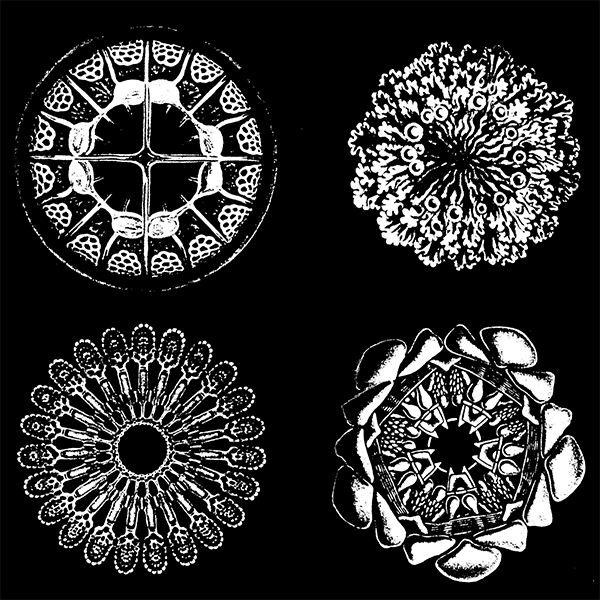
Top left: Species of rhizostomeae
Top right: Lichen
Bottom left: Gorgon-headed starfish
Bottom right: Sea urchin
Examples of the chakra forms found repeatedly in nature.
The body is a vehicle of consciousness. Chakras are the wheels of life that carry this vehicle about—through its trials, tribulations, and transformations. To run our vehicle smoothly, we need an owner’s manual as well as a map that tells us how to navigate the territory our vehicle can explore.
This book is a map for the journey to consciousness. You can think of it as a “user’s guide” to the Chakra System. This map, like any other, will not tell you where to go, but will help you navigate the journey you wish to take. Its focus is on integrating the seven archetypal levels that impact our lives.
With map in hand, we can embark on an exciting journey. Like all journeys, there is a certain amount of preparation needed in the form of background information: the psychological systems, the historical context of the Chakra System, a deeper study of just what the chakras are, and the related energy currents they describe. This gives us a language to speak on our journey. We will then be ready to take the journey itself, climbing up the spinal column, chakra by chakra.
Each chakra we encounter is a step on the continuum between matter and consciousness. Therefore, this journey will encompass areas of our lives ranging from the somatic level of physical and instinctual awareness through the interpersonal level of social interaction, and finally to the more abstract realms of transpersonal consciousness. When all of the chakras are understood, opened, and connected together, we have then bridged the gulf between matter and spirit, understanding that we, ourselves, are the Rainbow Bridge that connects Earth and Heaven once again.
In a fragmented world where mind is severed from body, culture from planet, and the material from the spiritual, we have a deep need for systems that allow us to reclaim our wholeness. These systems must allow us to integrate mind and body and take us to new and expanded realms without denying the mundane realities we all face on a daily basis. I believe the chakras provide just such a system—one we cannot do without and one whose time has come.
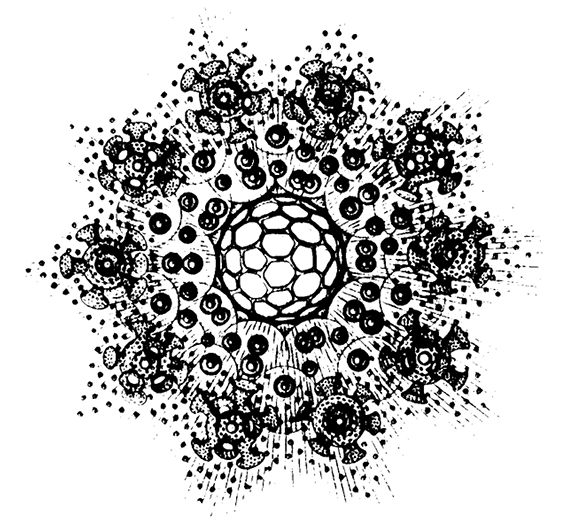
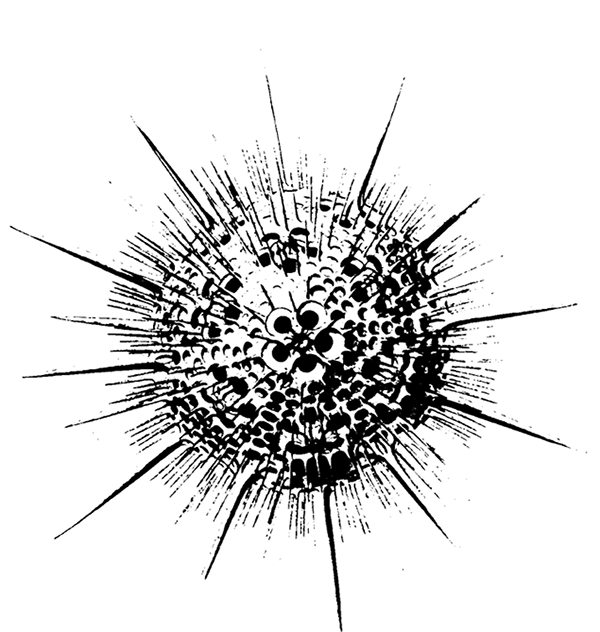
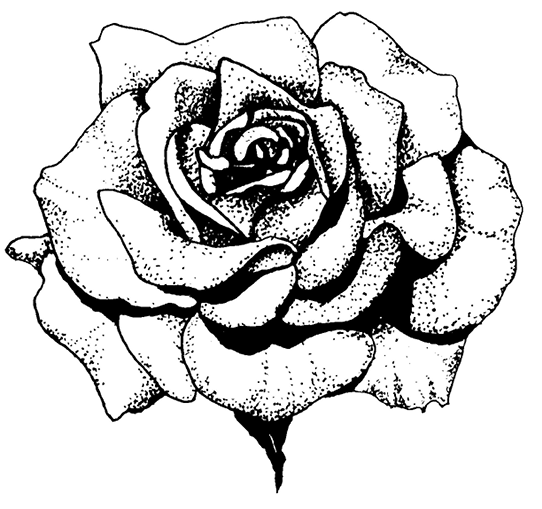
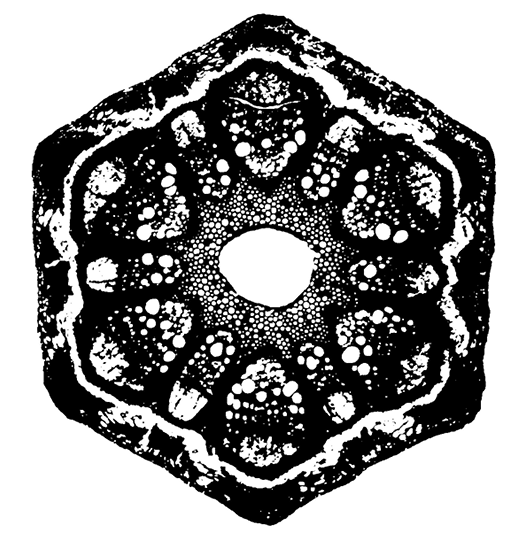
More examples of the chakra forms found repeatedly in nature.
APPROACHING THE SYSTEM
System—1) a complete exhibition of essential principles or facts, arranged in a rational or organized whole, or a complex of ideas or principles forming a coherent whole.
—Webster’s New Collegiate Dictionary
Imagine if you went to the library and found nothing but piles of books stacked helter-skelter across the floor. To find anything you would have to go through long and tedious hunting, with only a remote possibility of success. Ridiculously inefficient, you say.
Accessing consciousness without a system can be just as tedious. The circuitry in the brain allows for infinite possibilities of thought, and the manifestations of consciousness are far greater in number than the books in any library. Given the rhythm and speed of today’s life, we certainly cannot access this information without efficient systems to streamline the process.
Many systems exist already, yet are insufficient for the changing culture of today. Sigmund Freud’s division of the psyche into id, ego, and superego is a prime example of a simple system for studying human behavior, which formed the groundwork for psychotherapy in the early part of the twentieth century. Yet this model is now sorely inadequate, as it says little about the body, and even less about transcendent states of awareness.
Within the human potential movement, the need for new systems is quite evident. Clinics are opening to counsel people in psychic experiences as larger numbers are experiencing spontaneous awakenings of unusual spiritual energies. We are discovering ourselves confronted each day by new sets of problems. Biofeedback, Kirlian photography, acupuncture, homeopathy, Ayurvedic medicine, herbology, and myriads of New Age spiritual, verbal, and physical therapies are becoming more widely practiced each year. We now have so many options in healing, consciousness raising, religion, and lifestyles that the information and choices are overwhelming. The field has indeed opened up, and will certainly remain so if only we can derive some sense and order from the chaos. This is the purpose of a system. It gives us a systematic way to approach a complex task.
The logical way to build a system is to base it on the observation of persistent patterns. Many of these patterns have been described by our ancestors and passed down through the ages, shrouded in myth and metaphor, like dormant seeds waiting for the right conditions to sprout. Now, when we look for new directions for a changing age, perhaps it is time to archive the ancient systems of the past, dust them off, and upgrade them so that they are useful in the modern world in which we live. Before we do that, we must first examine the origin and evolution of that system, paying due respect to its ancient roots.
History of the Chakra System
It is wonderful that the chakras, as archetypal components of consciousness, are finally gaining prominence in the collective mindset, with more books and references than ever before. While this popularity is making the chakras a household word, it is also spreading a lot of confusing and conflicting information. It is important to realize the chakras come from an ancient tradition, which many New Age teachers have barely explored. Here is a brief summary of the Chakra System’s historical development for those who have an interest in its origin. (If you don’t have an interest, feel free to skip to the next section.)
The chakras are inextricably linked with the science and practice of yoga. The word yoga means “yoke,” and it is a system of philosophy and practice designed to yoke the mortal self to its divine nature of pure consciousness. The origin of yoga and earliest mention of the chakras2 goes back to the Vedas, meaning “knowledges”, a series of hymns that are the oldest written tradition in India. These writings were created from an even older oral tradition of the Aryan culture, believed to be an invading Indo-European tribe that swept into India during the second millenium b.c.e.3
The Aryans were said to have entered India on chariots, and the original meaning of the word chakra as “wheel” refers to the chariot wheels of the invading Aryans. (The correct spelling from Sanskrit is actually •cakra, though pronounced with a “ch” as in church, hence the English spelling chakra.) The word was also a metaphor for the sun, that great wheel that rolls across the sky like a blazing chariot of a cakravartin, the name for the Aryan chariot-rulers. The wheel also denotes the eternal cycle of time called the kalacakra. In this way, the wheel represents celestial order and balance. One further meaning is that a chakra is a Tantric circle of worshipers.
It is said that the cakravartins were preceded by a glowing golden disk of light, much like the halo of Christ, only this spinning disk was seen in front of them. (Perhaps their powerful third chakras?) The birth of a cakravartin was said to herald a new age, and it could be this time period that marked the dawning of the third chakra era of human history (see Chapter 13, “Evolution”). It is also said that the god Vishnu descended to Earth, having in his four arms a chakra, a lotus flower, a club, and a conch shell.4 This may also have referred to a chakra as a discus-like weapon.
Following the Vedas were the Upanishads, or wisdom teachings passed from teacher to disciple. There is some mention of the chakras as psychic centers of consciousness in the Yoga Upanishads (circa 600 b.c.e.) and later in the Yoga Sutras of Patanjali (circa b.c.e. 200). It is from Patanjali’s sutras that we get the classic eightfold path of yoga tradition.5 This tradition was largely dualistic, stating that nature and spirit were separate, and advised ascetic practices and renunciation of one’s instinctual nature as a way to enlightenment.
It was in the non-dual Tantric tradition that the chakras and Kundalini came to be an integral part of yoga philosophy. The Tantric teachings are a syncretic weaving of many spiritual traditions of India, which came to popularity during the sixth and seventh century a.d., in reaction to the dualistic philosophy which preceded it. This tradition advised being in the world rather than separate from it. Tantra is commonly viewed in the West as primarily a sexual tradition, as Tantrism does put sexuality in a sacred context and regards the body as a sacred temple for the consciousness within. Yet this is actually only a small part of a broad philosophy which combines many practices of hatha and kundalini yoga, worship of deities, especially of the Hindu goddesses, and focuses on integrating universal forces.
The word tantra literally means “loom” and denotes a weaving of disparate threads into a tapestry of wholeness. Thus, the Chakra System, coming out of Tantric tradition, weaves the polarities of spirit and matter, mind and body, masculine and feminine, Heaven and Earth, into a single philosophy of many philosophical strands, reaching even back to the oral tradition that preceded the Vedas.
The main text about chakras that has come to us in the West is a translation of Tantric texts by the Englishman Arthur Avalon in his book The Serpent Power published in 1919.6 These texts—the Sat-Cakra-Nirupana, written by an Indian pundit in 1577, and the Padaka-Pancaka, written in the tenth century—contain descriptions of the chakra centers and related practices. There is also another tenth-century text called the Gorakshashatakam, which gives instructions for meditating on the chakras. These texts form the basis of our understanding of chakra theory today.
In these traditions, there are seven basic chakras,7 which exist within the subtle body, interpenetrating the physical body. The subtle body is the nonphysical psychic body that is superimposed on our physical bodies. It can be measured as electromagnetic force fields within and around all living creatures. Kirlian photography, for example, has actually photographed the emanations of the subtle body in both plants and animals. In the aura, which is the external manifestation of the subtle body, the energy field appears as a soft glow around the physical body, often made of spindle-like fibers. In yoga psychology, the subtle body is divided into five sheaths of varying refinement in the subtle body, called koshas.8 At the core of the body, the subtle field appears as spinning disks—chakras. The chakras are the psychic generators of the auric field. The aura itself is the meeting point between the core patterns generated by the chakras and the influence of the external world.
Through modern physiology we can see that these seven chakras are located near the seven major nerve ganglia that emanate from the spinal column. (See Figure 1.3.) There are two minor chakras mentioned in the ancient texts, the soma chakra, located just above the third eye, and the Anandakanda lotus, which contains the Celestial Wishing Tree (Kalpataru) of the Heart Chakra (see further description, page 200). Some esoteric systems propose nine or twelve chakras,9 while other traditions, such as Vajrayana Buddhism, describe only five centers.10 Since a chakra is literally a vortex of energy, there is no limit to their number. However, the original seven “master” chakras form a profound and elegant system, one that maps logically onto the body through the nerve ganglia, yet connects our physical existence to higher and deeper non-physical realms. Mastering the first seven chakras can easily take a lifetime, and I advise people to work fully with these seven centers that relate to the body before undertaking more complex and obscure out-of-body systems.
While many interpretations on the chakras advise transcending the lower chakras in favor of the more expansive upper chakras, I do not agree with this philosophy, nor do I believe this is the intention of the Tantric texts. This view arose during a period in history where all the major patriarchal religions advocated the greater importance of mind over matter, thus denying the existence of the spiritual within the mundane realms. Careful reading of the Tantric texts does not imply the denial of the lower chakras in favor of the upper chakras, but merely an enfoldment, where each higher level is a transcendence, which includes and is built on the level below it. In this way, the lower chakras provide a foundation for our spiritual growth, much as the roots of a tree, which push downward, allow the tree to grow taller. We do not help the tree grow taller by pulling up its roots. This will be explored more fully as we explore the significance of the first chakra in the next chapter.
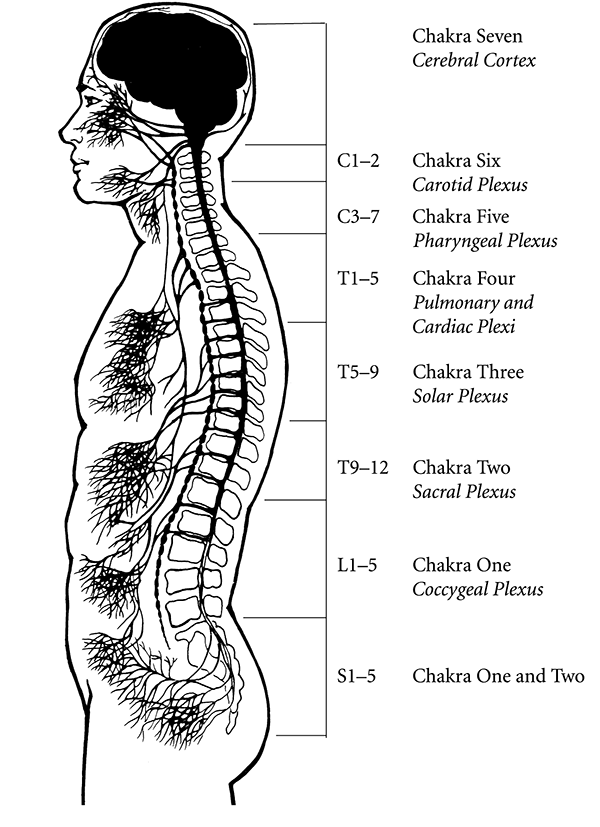
This diagram shows the vertebrae related to the different chakras based on the spinal nerves which innervate the ganglia and various organs. If these vertebrae are damaged in a way that affects the spinal nerves, the related chakras may be subsequently affected.
Systems From Other Cultures
Aside from Hindu literature, there are many other metaphysical systems featuring seven levels of man, nature, or physical planes. The Theosophists, for example, talk about seven cosmic rays of creation, with seven evolutionary races. The Christians talk about seven days of creation, as well as seven sacraments, seven seals, seven angels, seven virtues, seven deadly sins, and in Revelation 1:16 perhaps even seven chakras where it is said, “And He had in His right hand seven stars.” Carolyn Myss has also correlated the chakras to the seven Christian Sacraments.11
The Kabbalistic Tree of Life, also a system of studying behavior and consciousness, has seven horizontal levels distributed among its three vertical pillars and ten Sephiroth. Similarly, the Tree of Life describes a path from Earth to Heaven as does the Chakra System. While the Kabbalah is not an exact match to the Chakra System, it does have significant parallels in that it, too, describes an evolutionary journey from matter to supreme consciousness.12 Using the Chakra System in conjunction with the Kabbalah helps map the Sephiroth onto the body and brings together two ancient traditions, which obviously have common roots. (See Figure 1.4.)
Seven-ness is also found outside of myth and religion. There are seven colors to the rainbow, seven notes in the Western major scale, seven days in the week, and it is believed that major life cycles run in periods of seven years each—childhood to age seven, adolescence at fourteen, adulthood at twenty-one, first Saturn return at twenty-eight. Arthur Young in The Reflexive Universe has described evolution in seven levels,13 and the periodic table of elements can even be viewed as falling into a pattern of seven, by atomic weight.
Many cultures talk about energy centers or levels of consciousness similar to chakras, although there may not always be seven centers in their system. The Chinese have a system of six levels in the hexagrams of the I Ching, based on the two cosmic forces, yin and yang. There are also six pairs of organ meridians that correspond to five elements (fire, earth, metal, water, and wood). The Hopi Indians speak of energy centers in the body, as do the Tibetans.
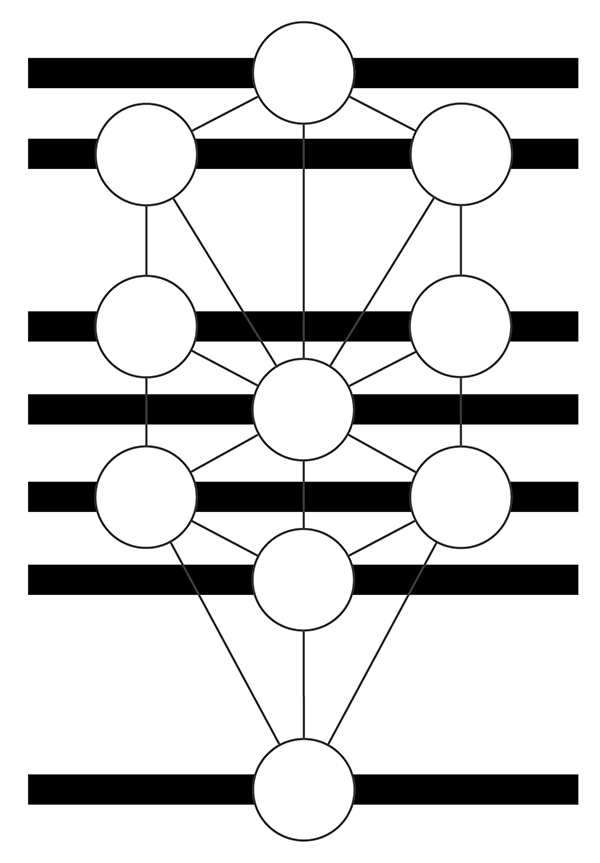
Kabbalistic Tree of Life, with its ten Sephiroth (circles),
twenty-two paths (lines connecting circles), three vertical pillars,
and seven levels (horizontal bars).
There is little doubt that there is a basic key to understanding within the correlation of all this myth and data. Somewhere there lies a cosmic map for adventurers in consciousness. Hints have been dropped through the ages around the globe. Is it not time we pieced together these clues and began to navigate ourselves out of our present difficulties?
Fortunately, more and more research is being done now that supports the existence of chakras,14 and their counterpart, the Kundalini energy. I hope that I can present enough of it within these pages to make this plain. I would prefer, however, to make this system believable to you primarily through your own personal experience and only secondarily through scientific evidence. The scientific aspects provide little practical value in actually using the system other than intellectual reassurance, since the chakras are ultimately an interior subjective experience. Knowing about the chakras is only part of the journey. The real challenge is to experience them.15
So, in order to understand the merits of this most ancient and now modernized system, I urge the reader to suspend disbelief within whatever parameters they find comfortable, jump aboard the mystic bandwagon of personal experience, and judge their truths from within. After all, this is little more than what we do in reading a good adventure novel or love story. Consider this book a little of each—an adventure novel traveling through the realms of your own consciousness, and a love story between your inner self and the universe that surrounds you.
HOW THE CHAKRAS WORK
Now that we have examined the history of the Chakra System, let’s take a deeper look at the chakras themselves, and examine how they might work their powerful influence on mind and body.
As mentioned before, the word chakra is a Sanskrit word meaning “wheel” or “disk” and denotes a point of intersection where mind and body meet. Chakras are also called lotuses, symbolizing the unfolding of flower petals, which metaphorically describe the opening of a chakra. The beautiful lotus flowers are sacred in India. Growing from mud, they symbolize a path of development from a primitive being to a fully blossoming consciousness, mirroring the base chakra rooted in Earth, which evolves into the “thousand-petaled lotus” at the crown of the head. Like lotuses, chakras have “petals,” which vary in number from chakra to chakra. Beginning at the bottom with the first chakra, the petals number four, six, ten, twelve, sixteen, two, and 1,000 petals. (See Figure 1.5.) Like flowers, chakras can be open or closed, dying or budding, depending on the state of consciousness within.
The chakras are gateways between various dimensions—centers where activity of one dimension, such as emotion and thought, connects and plays on another dimension, such as our physical bodies. This interaction, in turn, plays on our our interactions with others and thus influences another dimension—our activities in the outside world.
Take, for example, the emotional experience of fear, related to the first chakra. Fear affects our body in certain ways. We feel butterflies in our stomach, our breath is short, and our voice and hands may shake. These physical characteristics betray our lack of confidence in dealing with the world, and may lead others to treat us in a negative way, perpetuating our fear. This fear may have its roots in an unresolved childhood experience, yet still rules our behavior. To work with the chakras is to heal ourselves of old constricting patterns lodged in the body or the mind, or habitual behavior.
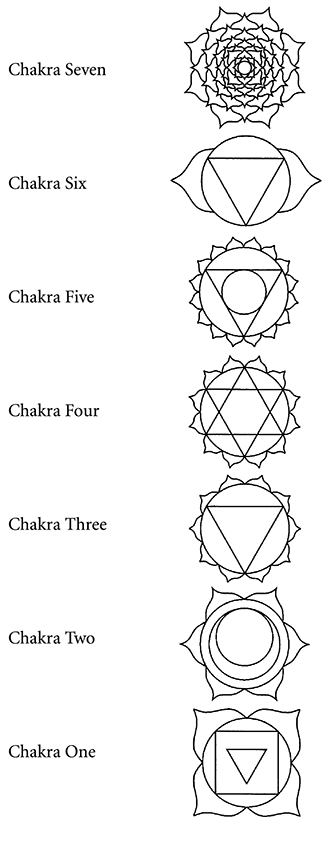
Seven lotuses representing the seven chakras.
The sum total of the chakras forms a vertical column in our bodies called sushumna. This column is a central integrating channel for connecting the chakras and their various dimensions. (See Figure 1.6.) It can be thought of as a “super highway” on which these energies travel, just as our asphalt highways are channels through which physical items travel from the manufacturer to the consumer. We could say that the sushumna brings psychic energy from the “manufacturer” as pure consciousness (Divine Mind, God, Goddess, The Force, Nature, etc.) to the consumer, which is the mental and physical individual here on the Earth plane. One could view the chakras as being major cities located along the highway, each responsible for producing their own kind of goods. Rather than cities, however, I view them as sacred chambers in the temple of the body, where the vital force of consciousness can pool together on different levels.
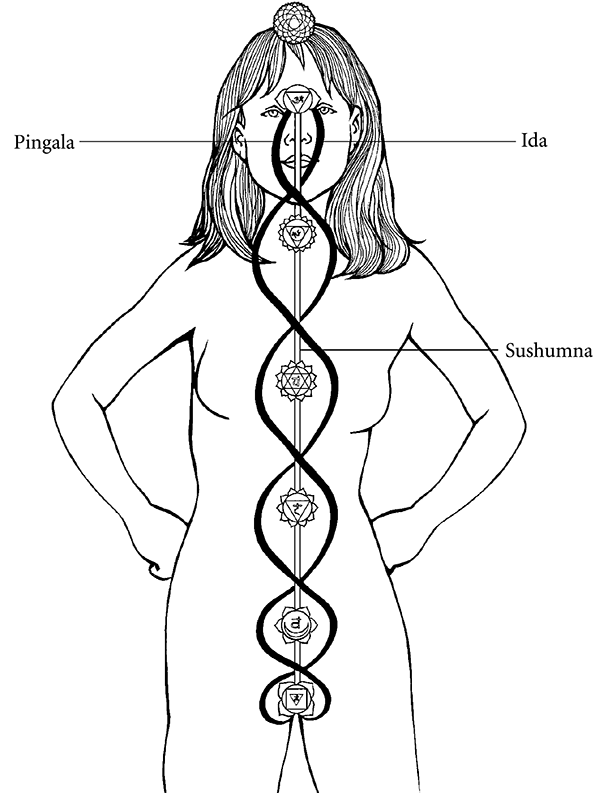
Sushumna, Ida, and Pingala.
(Author’s Note: Some texts show Ida and Pingala crossing between the chakras, while others show them crossing at the chakras. Others describe the currents ending—or beginning—at the left and right nostril.)
Traveling beside, around, and through the sushumna, there are also many back roads, such as the Chinese acupuncture meridians, and the thousands of other nadis, subtle energy conduits, which Hindus have found within the subtle body. (See Figure 1.7.) Nadis can be thought of as alternate channels, such as the telephone network, gas lines, or stream beds, where we have special channels for moving certain kinds of energy, all passing through the same vortex.
If you would like to experience what a chakra feels like, the following is a simple exercise for opening the hand chakras and experiencing their energy:
Extend both arms out in front of you, parallel to the floor with elbows straight.
Turn one hand up and one hand down. Now quickly open and close your hands a dozen times or so.
Reverse your palms and repeat. This opens the hand chakras.
To feel their energy, open your hands and slowly bring your palms together, starting about two feet apart.
When your hands are about four inches apart you should be able to feel a subtle ball of energy, like a magnetic field, floating between your palms. If you tune in closely, you may even be able to feel it spinning.
After a few moments the sensation will subside, but it can be repeated by opening and closing the palms again, as above.
On a physical level, chakras correspond to nerve ganglia, where there is a high degree of nervous activity, and also to glands in the endocrine system (see Figure 1.8). While chakras are interdependent with the nervous and endocrine systems, they are not synonymous with any portion of the physical body, but exist within the subtle body.
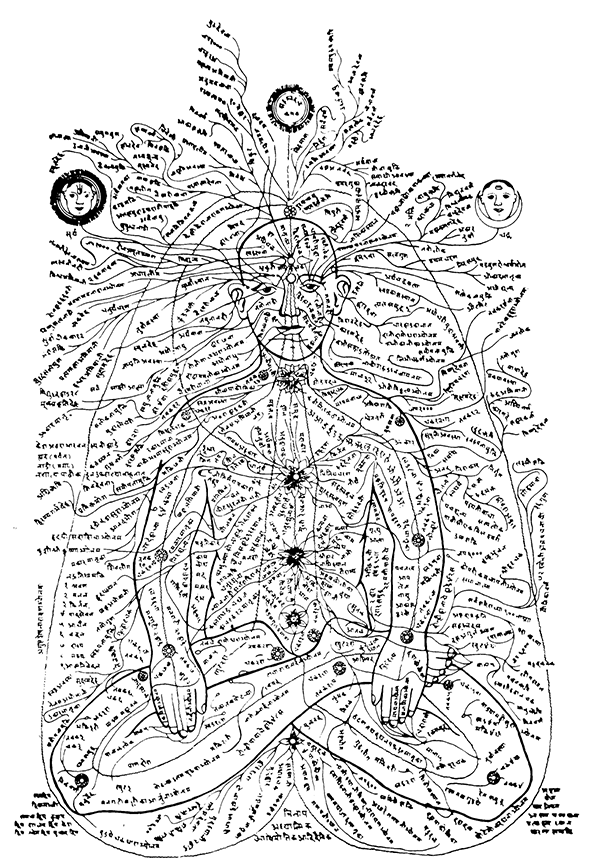
Ancient Hindu drawing of the nadis and chakras.
(Courtesy of University of the Trees Press)
Yet their effect upon the physical body is strong, as witnessed by anyone undergoing a Kundalini experience. I believe that the chakras generate the shape and behavior of the physical body, much as the mind influences our emotions. An excessive third chakra would exhibit a big, tight belly; a constricted fifth chakra results in tight shoulders or a sore throat; a poor connection through the first chakra may show up in skinny legs or bad knees. The alignment of one’s spinal vertebrae also correlates to the openness of the chakras. For example, if our chest is collapsed, due to spinal curvature or somatic/emotional holding, the heart chakra may be impeded. The shape of our physical body may even be determined by our development from former lives, to be picked up and continued again in this life.
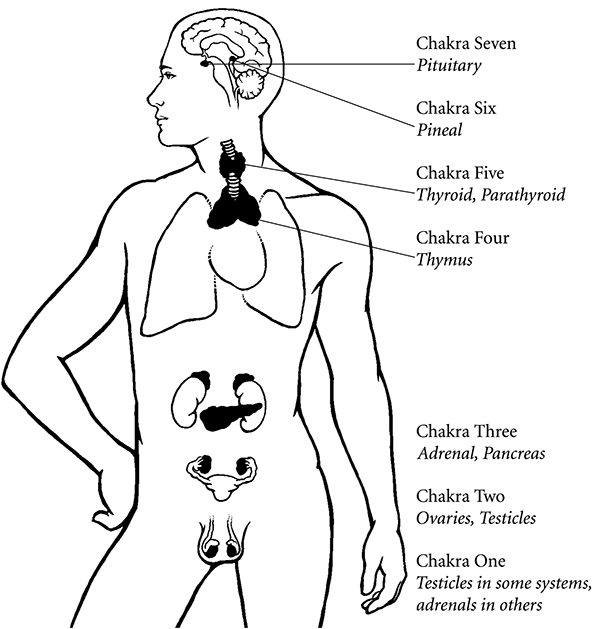
Common associations between the chakras
and the glands of the endocrine system.
(Some systems reverse chakras six and seven, making pineal a seventh chakra gland and the pituitary related to the sixth.)
In metaphysical terminology, a chakra is a vortex. (Figure 1.9.) Chakras spin in a wheel-like manner, attracting or repelling activity on their particular plane by patterns analogous to a whirlpool. Anything the chakra encounters on its particular vibrational level gets drawn into the chakra, processed, and passed out again.
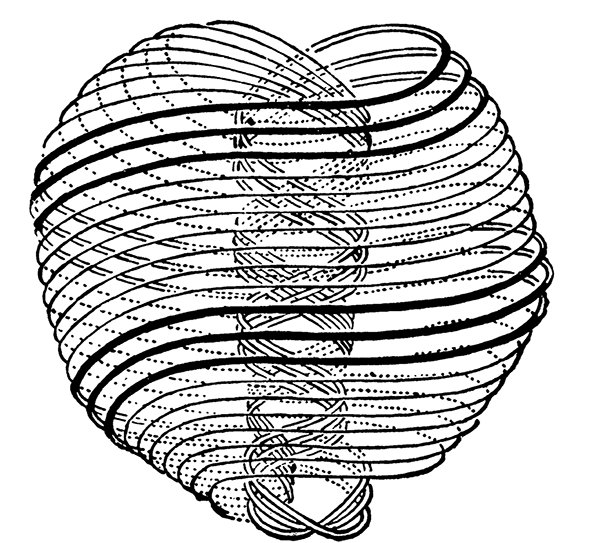
Metaphysical illustration of a vortex.
(Courtesy of Theosophical Publishing House)
Instead of fluid, chakras are made of symbolic patterns of our own mental and physical programming. This programming governs the way we behave. Like programming in a computer, it channels the way energy flows through the system and gives us different kinds of information. Each chakra—which literally means “disk”—can be thought of as programming on a floppy disk that runs certain elements of our lives, from our survival programs, to our sexual programs, to the way we think and feel.
Chakras send energy out from the core of the body, and they assimilate energy from outside that enters the core. In this way, once again, I define a chakra as an organizational center for the reception, assimilation, and transmission of life energy. What we generate determines much of what we receive, and in this way it behooves us to work on our chakras and clean up outdated, dysfunctional, or negative programming that may be getting in our way.
The content of the chakras is formed largely by repeated patterns from our actions in day-to-day life, as we are always the center point of these actions. Repeated movements and habits create fields in the world around us. Programming from our parents and culture, our physical body shape, situations we are born into, and information from previous lives are also important factors. These patterns can often be seen by clairvoyants when viewing the chakras. Their interpretations give us valuable insight into our behavior. Like an astrological chart, they show us tendencies of the personality, but are not by any means unchangeable. Knowing our tendencies tells us what to watch out for and what to enhance.
Through involvement with the outside world, patterns within the chakras tend to perpetuate themselves; hence the idea of karma—patterns formed through action, or the laws of cause and effect. Thus it is common to become trapped in any one of these patterns. This is called being “stuck” in a chakra. We are caught in a cycle that keeps us at a particular level. This could be a relationship, a job, a habit, but most often, simply a way of thinking. Being stuck can be a function of either overemphasis or underdevelopment of a chakra. The object of our work is to clean the chakras of old, nonbeneficial patterns so that their self-perpetuating actions have a positive influence, and our life energy can continue to expand to higher planes.
Chakras are associated with seven basic levels of consciousness. As we experience the opening of a chakra, we also experience a deeper understanding of the state of consciousness associated with that level. These states can be summarized with the following keywords, though it must be remembered that these words are a gross oversimplification of the complexity of each level. (See Table of Correspondences) The chapters that follow will explain each chakra more fully. Their associated elements are given because the elements are of such crucial significance to understanding the quality of the chakra.
Chakra One: Located at the base of the spine, is associated with survival. Its element is earth.
Chakra Two: Located in the lower abdomen is associated with emotions and sexuality. Its element is water.
Chakra Three: Located in the solar plexus, is associated with personal power, will, and self-esteem. Its element is fire.
Chakra Four: Located over the sternum, is associated with love. Its element is air.
Chakra Five: Located in the throat, is associated with communication and creativity. Its element is sound.16
Chakra Six: Located in the center of the forehead, is associated with clairvoyance, intuition and imagination. Its element is light.
Chakra Seven: Located at the top of the head, is associated with knowledge, understanding and transcendent consciousness. Its element is thought.
Chakras can be open or closed, excessive or deficient,17 or any of the various stages in between. These states may be basic aspects of someone’s personality throughout most of their life, or something that changes from moment to moment in response to a situation. An ailing chakra may be unable to change its state easily, being stuck in either an open or a closed state. The chakra then needs healing by uncovering and removing whatever is blocking it. If a chakra is blocked in a closed state, then it is unable to generate or receive energy on that particular plane, such as love energy or communication. If a chakra is blocked in an open or excessive state, that means it tends to channel all energies through that particular plane, such as using all situations to further one’s power or meet sexual needs, when other forms of behavior might be more appropriate. A closed chakra is a chronic avoidance of certain energies, while an excessively open chakra is a chronic fixation.
The quality and quantity of energy that one encounters on a particular plane has to do with how open or closed their respective chakra is, or how able they are to control this opening and closing at appropriate times. This governs the amount of activity and complexity we can effectively handle at any given level.
For example, someone with a tightly closed third chakra (personal power) would be terrified of confrontation, while another who is more open, may thrive on it. Someone with an open second chakra (sexuality) may juggle many sexual partners, while someone who is closed may avoid even feeling sexual. Someone whose throat chakra is excessive may talk too much and not really listen, while another may be scarcely able to get their words out.
There are specific exercises that are designed to facilitate the opening, discharging, or strengthening of each center, but one must first be able to understand the system as a whole. Once the system is understood, individual levels can be approached in various ways. One can:
• Focus attention on that area of the body, taking careful note of how it feels and behaves.
• Understand the philosophical working of that chakra and apply it.
• Examine the interactions in one’s day-to-day life that level corresponding to that chakra.
In this work, any of the correlations to a particular level can be used to access the chakra and change the energy within.
For example, you can understand what condition your second chakra (sexuality) is in by first tuning in to that area of the body (abdomen, genitals). Is it fluid, alive, painful, tense, relaxed? The physical state gives us many clues about the internal processes. The next step is to examine the meaning and function of that particular chakra. What meaning do you ascribe to emotions and sexuality? What values do they hold for you? What kind of programming did you receive about those issues? Then you might examine the quality and quantity of emotional and sexual interaction in your life. Is it what you want it to be? Is it balanced between give and take? Is it an effortless flow of energy or a subject of fear and anxiety?
You can then work on improving the health of the second chakra by doing any of the following:
• Doing physical exercises that pertain to relaxing, opening, or stimulating the sacral area of the body.
• Working with its associated images, colors, sounds, deities, or elements, such as its constant movement and flow of water or its cleansing properties by: drinking lots of water, visiting a river, going swimming—all as a means to connect with its associated water element.
• Working through your feelings and values about sexuality and emotions, and bringing those new insights into your behavior with others.
Any or all of these processes may affect changes in your emotional or sexual nature.
The body and mind are inseparably interrelated. Each governs and affects the other, and each is accessible through the other. The seven major chakras are also inseparably interrelated. A block in the functioning of one chakra may affect the activity of the one above or below it. For example, you may have trouble with your personal power (third chakra) because of a block in communication (fifth chakra) or vice versa. Or perhaps the real problem may lie in your heart (fourth chakra) and only manifests in these other areas because it is buried so deeply. In examining the theoretical System as a whole (which will henceforth be capitalized) and applying it to your personal chakra system (lowercase) as it occurs uniquely within you, you learn to sort out these subtleties and patterns and make self-improvements according to your goals. This process will be explained in greater detail as we explore each chakra in depth.
Chakras exist in many dimensions simultaneously, and thus provide points of entry into those dimensions. In the physical realm, they correspond to particular areas of the body and may be experienced as butterflies in our stomach, frogs in our throat, pounding in our heart, or the experience of an orgasm. Working with the physical associations allows us to use the Chakra System to diagnose and, in some cases, heal illnesses.
Chakras also correspond to various types of activity. Work is a first chakra activity, as it relates to survival. Music, relating to sound and communication, corresponds to the fifth chakra. Dreaming, as a function of inner sight, is a sixth chakra activity.
In the dimension of time, chakras describe stages in personal and cultural life cycles. In childhood, the chakras open sequentially, starting with the first chakra, which is dominant during the first year of life, and moving upward toward the crown as we mature into adulthood.18 As adults, we may focus on certain chakras more than others at various stages—creating prosperity, exploring sexuality, developing personal power, relationships, creativity, or spiritual exploration.
In terms of evolution, chakras are paradigms of consciousness that prevail in the world at a given time. Primitive humans existed primarily in the first chakra, where survival was the main focus of culture. Agriculture and ship travel marked the beginning of the second chakra era. At this millennial time, I believe we are passing from the third chakra era, where the primary focus has been power and energy, to the fourth chakra realm of the heart, where the focus is on love and compassion. While none of these transitions are smooth or sudden, certain phases can be clearly seen over the course of history. (See chapter 12.)
In the mind, chakras are patterns of consciousness—belief systems through which we experience and create our personal world. In this way, the chakras really are programs that run our lives. Our lower chakra programs contain information about the body in terms of survival, sexuality, and action. The higher chakras bring us to more universal states of consciousness and work with our deeper belief systems about spirituality and meaning. Sometimes we get locked into a program and it becomes our habitual way of interacting with the world around us. The man who sees every situation as a challenge to his power orients from his third chakra. The one who perpetually struggles with survival issues, such as health and money, has difficulty with chakra one. Someone who lives in his fantasies may be stuck in chakra six.
As you can see, the chakras have many complexities. As metaphors for the manifestation of consciousness on various planes of activity, they are invaluable. Yet, as a complete System, they offer even more understanding to the energetic dynamics of a human being.
SHIVA AND SHAKTI
There is no power-holder without power. No power without power-holder. The power-holder is Shiva. Power is Shakti, the Great Mother of the universe. There is no Shiva without Shakti, or Shakti without Shiva. 19
In Hindu mythology, the universe is created by the combination of the deities Shiva and Shakti. The male principle, Shiva, is identified with pure unmanifest consciousness. He represents bliss and is depicted as a formless being, deep in meditation. Shiva is the inactivated divine potential equal to pure consciousness—separate from its manifestations. He is sometimes seen as the “destroyer” because he is consciousness without form—often destroying form to reveal consciousness. Shiva is believed to have the strongest presence at the crown chakra.20
Shakti, the female counterpart to this inactive consciousness, is the life giver. She is the entire creation and mother of the universe. Shakti, in her creation of the world, is the inventor of maya, commonly thought of as illusion. Early in the Sanskrit language, maya had the meaning of magic, art, wisdom, and extraordinary power.21 maya is the substance of the manifested universe, the mistress of divine creation. Maya is a projection of consciousness, but not consciousness itself. It is said that when “karma ripens, Shakti becomes desirous of creation and covers herself with her own maya.”22
The root word shak means “to have power” or “to be able.”23 Shakti is the vital energy that gives power to the forming of life. It is through union with Shakti that the consciousness of Shiva descends and endows the universe (Shakti) with Divine Consciousness. Among mortals, the woman produces the child, but only with the man’s seed. So, too, Shakti produces the universe, but only with the “seed” of consciousness that comes from Shiva.
Each of these deities has a tendency to move toward the other. Shakti, as she pushes up from the Earth, is described as the “divine aspiration of the human soul,” while Shiva, descending from above, is the “irresistible attraction of divine grace” or manifestation.24 They exist in an eternal embrace and are constantly making love, neither able to exist without the other. Their eternal relationship creates both the phenomenal and spiritual worlds.
Shiva and Shakti reside within each one of us. We have only to practice certain principles to allow these forces to join together bringing us enlightenment from the veil of maya, or realization of the consciousness buried within so-called illusion. When this occurs we will have, as the old meanings hint—art, wisdom, and the powers of creation within our very grasp.
LIBERATION AND
MANIFESTATION
Consciousness thus has a twin aspect; its liberation (mukti) or formless aspect, in which it is as mere Consciousness-Bliss; and a universe or form aspect, in which it becomes the world of enjoyment (bhukti). One of the cardinal principles [of spiritual practice] is to secure both liberation and enjoyment.25
Shiva and Shakti can also be seen as representing two currents of energy through the chakras—one downward and one upward.26 (See Figure 1.10, page 33.) The downward current, which I call the current of manifestation, begins in pure consciousness and descends through the chakras into the manifested plane, gradually becoming denser and denser at each step. To produce a theatrical play, for example, we must begin with an idea or concept (chakra seven). The idea then becomes a set of images (chakra six), which can be communicated to others in the form of a story (chakra five). As the idea further develops, and others get involved with it, we enter a set of relationships that help bring it about (chakra four). We give it our will and energy (chakra three), rehearsing the movements, and bringing its conceptual and physical elements together (chakra two) and finally, manifest the play on the physical plane (chakra one) in front of an audience. Thus we have taken our abstract conception which began in thought down through the chakras into manifestation. It is this path of manifestation that is said to be pulled by the enjoyment of life, or bhukti.
The other current, called the current of liberation, takes us out of the limitations of the manifested plane into freer and thus more expansive and inclusive states of being. In this path, the energy in matter is released to become lighter and lighter, as it moves up through the elements, expanding and transforming to a limitless state of pure being. Thus solid earth loses its rigidity and becomes water, then the energy of fire, the expansion of air, the vibration of sound, the radiation of light, and the abstraction of thought.
The liberating current is the pathway usually emphasized in the study of chakras, for it brings personal liberation. It is the pathway through which slow-moving, constricted energy gradually gains new degrees of freedom. It liberates us from outdated or constricting habits, from the veil of maya. It is the pathway through which we disentangle ourselves from the limitations of the physical world and find broader scope in the more abstract and symbolic levels. Each step along the liberating pathway is a rearrangement of matter and of consciousness, to produce more efficient, energy-rich combinations, a dissolution into our primary source. As this current originates below, it is fueled by the lower chakras—our roots, our guts, our needs, and desires.
While suffering from much prejudice, the downward current is equally important for it enables us to manifest. Each step downward is a creative act, an act of consciousness making choices, taking a step toward limitation, allowing constriction of freedom. Through this constriction, the abstract expanse of consciousness has a container that allows it to condense and become solid. In the downward current, each of the chakras can be seen as “condensers” of cosmic energy.
To manifest, we must limit. This requires creating boundaries, being specific, defining structure and form. To write this book, I must have structure to my life and limit my other activities long enough to complete it. To hold a job, raise a child, finish school, or to create anything tangible, we must be willing to accept limitation.
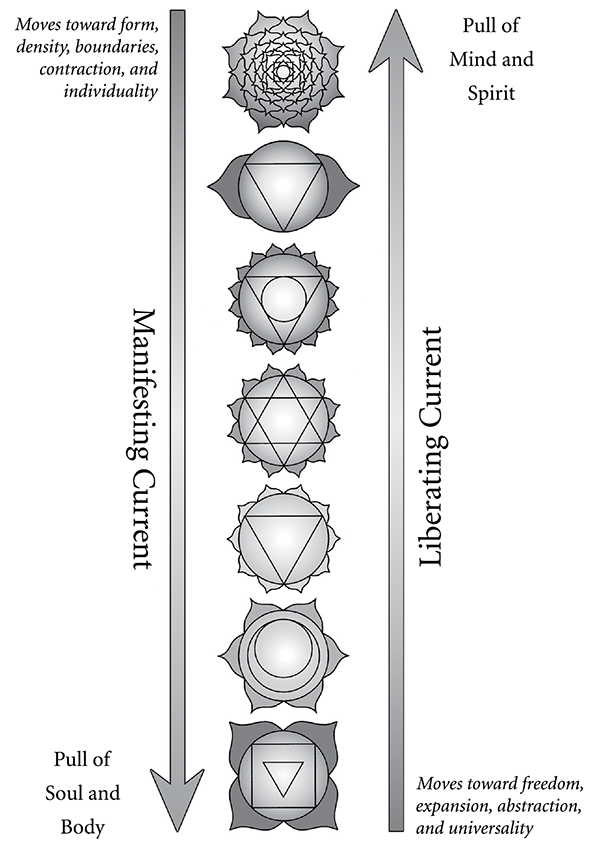
Figure 1.10
The current of manifestation and the current of liberation.
The liberating current brings us excitement, energy, and novelty, while the descending current brings peace, grace, and stability. In order for either of these pathways to really be complete, all of the chakras need to be open and active. Liberation without limitation leaves us vague, scattered, and confused. We may have wonderful ideas and lots of knowledge, but we are unable to bring these fruits to any tangible completion. On the other hand, limitation without liberation is dull and stifling. We become caught in repetitive patterns, clinging to security and fearing change. In order for us to be truly whole, both currents must be open and active.
The chakras may be thought of as chambers in the body where these two forces mix together in different combinations. Each chakra has a different balance of liberation and manifestation. The lower we go in the system, the stronger the momentum of the manifesting current. The higher we go, the more the chakras are influenced by the liberating current. This basic polarity is an essential element to understanding how the system works as a whole.
THE THREE GUNAS
In Hindu mythology, the cosmos is believed to have evolved out of a primordial ground called prakrti, similar to the Western alchemical concept of prima materia. Prakrti is woven from three threads called gunas, or qualities, which create all that we experience. These qualities correspond, in our terms, to matter, energy, and consciousness.
The first of the gunas is called tamas, and it represents matter, mass, or the heavy stillness of inertia. It is prakrti in its densest form. The second guna is called rajas, representing energy in the form of motion, force, and the overcoming of inertia. This is prakrti in its energetic, changing form. The third is called sattva, meaning mind, intelligence, or consciousness. This is prakrti in its abstract form. The gunas can also be described as tamas, the magnetic force, rajas, the kinetic force, and sattva, the balancing force between these two. Sattva rules the causal plane, rajas rules the subtle plane, and tamas, the gross or physical plane.
In the continuous creation of the cosmos, the three gunas intertwine to form the various states or planes of existence that we experience. Arising from a basic state of equilibrium, the gunas maintain this equilibrium through constant flux. Other times tamas may dominate, giving us matter. At times rajas may dominate, giving us energy. When sattva is predominant, the experience is primarily mental or spiritual. However, the three gunas always retain their own essence, much as the three strands of a braid remain distinct, yet weave together to make one braid.
The totality of the gunas is believed to remain constant, mirroring the principles of energy conservation accepted by physics today. Within our braid, we may alter the number of strands in each section, yet the total size of the braid remains constant.
The chakras are comprised of varying proportions of the three gunas. These three qualities are the essence of a basic, unified primordial substance. Together they compose the dance of the universe, yet separately they are quite distinct. The gunas describe the steps in a cosmic dance and, by studying their interrelationship, we may learn the steps and join in the dance ourselves.
In the following pages, the terms matter, energy, and consciousness will be used quite freely. These terms describe qualities inherent in all aspects of life—the qualities of the three gunas. These terms are not three separate entities and are never found alone without varying proportions of their counterparts. In fact, it is impossible to actually separate them except under an intellectual framework. Energy, matter, and consciousness intertwine to form all that we experience in the same way as the gunas join together to form the cosmos.
The chakras are all comprised of these ingredients in various degrees. Matter (tamas) rules the lower chakras, energy (rajas) rules the middle chakras, and consciousness (sattva) rules the upper chakras. Yet some proportion of each thread is found at every level and in each and every living thing. To balance the weaving of these three basic threads is to bring balance to ourselves, in mind, body, and spirit.
CHAKRAS AND KUNDALINI
Her lustre is that of a strong flash of young lightning. Her sweet murmur is like the indistinct hum of swarms of love-mad bees. She produces melodious poetry . . . It is She who maintains all the beings of the world by means of inspiration and expiration, and shines in the cavity of the root lotus like a chain of brilliant lights.
—Sat-Chakra-Nirupana27
When Shakti resides in the base chakra, she rests. Here she becomes the coiled serpent, Kundalini-Shakti, wrapped three and one-half times around the Shiva lingam in the Muladhara. In this form she is the inherent potential in matter, the primordial feminine force of creation, and the evolutionary force in human consciousness. In most people she remains dormant, peacefully sleeping in her coiled abode at the base of the spine. Her name comes from the word kundala, which means “coiled.”
When awakened, this Goddess unfolds from her coils and climbs upward, chakra by chakra, reaching for the crown chakra at the top of the head where she hopes to find Shiva descending to meet her. As she pierces each chakra, she brings that chakra’s awakening to her subject. In fact, some believe it is only Kundalini-Shakti who can open the chakras. If she is able to reach the crown chakra and complete her journey, she is united with her counterpart, Shiva, Divine Consciousness, and the result is enlightenment or bliss.
Kundalini yoga is an ancient and esoteric discipline designed to arouse the Kundalini-Shakti force and raise it up the spine. It often involves initiation by a trained guru and years of specific yoga and meditation practices. However, there are many people on and off the spiritual path who are having spontaneous spiritual emergence experiences, some with genuine Kundalini awakenings, so it is worthwhile to examine this mysterious and powerful force.
The paths Kundalini takes are quite varied. Most commonly Kundalini begins at the feet or the base of the spine and travels up toward the head. This movement can be accompanied by shaking spasms or feelings of intense heat. Accounts of Kundalini, however, also include similar intense activity traveling from the head downward or from the middle outward. Sometimes Kundalini symptoms happen within a matter of seconds and then vanish, occurring at intervals of hours or years. At other times, the symptoms may last for weeks, months, or years.
Kundalini is generally a unique and powerful experience that results in a profound consciousness change. This change may be experienced as increased alertness, sudden insight, visions, voices, a feeling of weightlessness, a sense of purity within the body, or transcendent bliss. There is some evidence that Kundalini sets up a wavelike movement of the cerebrospinal fluid, which triggers the pleasure centers of the brain, giving us the “blissful state” so often described by mystics.
A Kundalini experience is not always pleasant, however. Many people have extreme difficulty functioning in their mundane lives while Kundalini is thrashing about through their chakras. While Kundalini pushes her way through your blocks, you may find difficulty sleeping or a dislike for energies associated with the lower chakras, such as eating or sex. (Yet some people become highly sexual after a Kundalini awakening.) There may also be some profound depression or fear as you look at your life through the eyes of this serpent Goddess. She is a healing force, though not always gentle, as the veils of illusion are drawn away from your normal reality. For those who experience spontaneous Kundalini awakenings and do not have a spiritual teacher to work with, there are some referral agencies that can provide you with experienced therapists who understand this spiritual energy and will not necessarily judge it as crazy or psychotic.28
The serpent is an archetypal symbol throughout the world representing enlightenment, immortality, and a path to the Gods. In Genesis, the serpent led Adam and Eve to taste the fruit from the Tree of Knowledge. This symbolizes the beginning of Kundalini, creating the unceasing desire for understanding, yet grounded in the material world (the apple). In Egypt, the pharaohs wore crowns with serpent symbols over their third eye to represent their godly stature. Did this represent ascended Kundalini? Even today the double serpent wraps itself around the staff of healing, forming the modern medical symbol, the caduceus. (See Figure 1.11, page 39.) The caduceus clearly imitates the winding of Ida and Pingala, the central nadis crossing between the chakras, surrounding the sushumna. (See Figure 1.6, page 19.) The entwined serpents are also symbolic of the double helix pattern of our DNA—the basic information-carrier of life.
Kundalini is a universal concept for a very powerful enlightening force. It is also a very tricky and unpredictable force to play around with; one which may be loaded with intense pain, confusion and frequently may be interpreted by the world as insanity. This may or may not be accompanied by the more positive aspects listed above. It opens the chakras, but like opening each cell in a jail, Kundalini may release whatever is lodged within the chakras. This may be expanded insights or experiences, or it may be old traumas or abuses that caused the chakra to shut down originally.
Kundalini does produce a profound state of consciousness, and this resulting state of consciousness may make it very difficult to get along in a world so predominantly “unenlightened.” It may not support our current paradigm or be harmonious to the circumstances in our lives or the physical state of purity within the body. These discrepancies may make for a great deal of discomfort, but are not always to be avoided. Kundalini is basically a healing force, and pain is felt only when it encounters tension and impurities we are not quite ready to release. Learning to open the chakras allows a clear path for Kundalini that is less apt to be painful.
Theoretically, Kundalini produces a force that helps open the crown chakra, located at the top of the head. Because blocks in the chakras may trap our spinal energy, this chakra is often the hardest to reach. Classically, the crown chakra is considered the seat of enlightenment; however, I believe that it is the combined presence and connection of all the chakras together, given conscious attention, that brings enlightenment. With many people, their more enlightening moments come from bringing upper chakra consciousness down to tangible recognition, rather than the other way around.
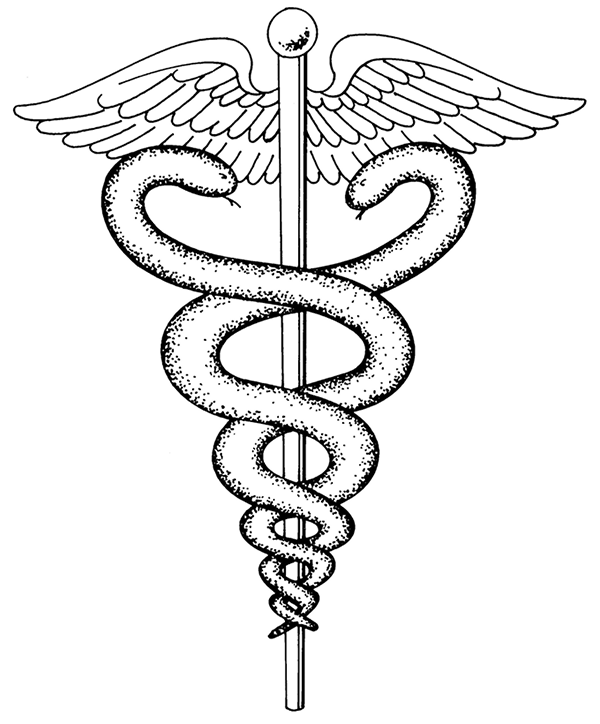
Figure 1.11
The caduceus, the modern symbol for healing, traces the
path of the chakras and nadis, emanating from the base
to the two winged petals at the top.
The raising of energy to higher chakras occurs naturally and spontaneously when we relax deeply and pay attention to all of our chakras. Attempts to force the energy to rise often results in strain, tension, and a feeling of being “spaced out” or irritable to all those around us who are not doing the same thing. The latter produces an alienation that I have found to be symptomatic of a lack of enlightenment. (Many people have come up to me at conferences to excitedly tell me of their enlightened seventh chakra experiences, while not having the slightest sensitivity to the fact that they were rudely interrupting a conversation, or were living in bodies that seemed horribly neglected.)
It is impossible to talk about chakras without mentioning Kundalini, however, the raising of Kundalini is not the focus of this book. Kundalini is not necessarily the best or easiest way to achieve realization any more than driving through a stone wall is the easiest way to get to the house on the next street. There are times when a strong force is needed to get through a particularly stubborn block, but I prefer methods that are natural, safe, and pleasant. When we take the scenic route, we can enjoy the journey as much as the destination.
This book neither supports nor condemns disciplines designed to arouse Kundalini. The drug LSD is a quick way to catch glimpses of the higher worlds of superconsciousness, and it doesn’t necessarily leave you there but may still effect some permanent change in a positive direction. Kundalini is even less predictable, generally more profound, and much more difficult to obtain. However, Kundalini is not the result of a drug, but a reorganization of our own life energy. It is a unique and valuable experience available to any sincere seeker of higher awareness.
What pain we encounter is only from our own resistance and the impurities Kundalini must burn away before she can reach her goal.
There is a great deal of research that is presently being done on Kundalini, and many theories have been formed about what it really is and how it is triggered. The theories listed below are the ones most pertinent to this book.
• Kundalini is triggered by a guru. Any interaction we have with other people takes place on a chakra level as well. (See Figure 1.12, page 45.) If we interact with people who are predominantly lower chakra, our own centers respond accordingly. We may be pulled down by such an interaction. Likewise, if an interaction occurs that stimulates the upper chakras, such as contact with a guru who has awakened his or her own Kundalini, this new influx of energy may awaken the disciple. When Kundalini is triggered by a guru, the experience is called Shaktipat. It awakens the centers and gets the Kundalini energy flowing, leaving its recipient free to experience both the wonderful effects as well as deal with the
consequences it may affect in their lives and body.
• Kundalini is sexual. The practice of Tantra sometimes includes elaborate yogic sexual practices, designed to arouse Kundalini and achieve transcendence. Such techniques may vary from prolonged orgasm to total abstinence. Some say Kundalini and sexuality are mutually exclusive, while others believe they are inextricably linked. This will be discussed more fully in the chapter on chakra two.
• Kundalini is chemical. The sixth chakra is generally associated with the pineal gland. Melatonin, a chemical produced by this gland, is known to produce increased psychic ability, dream recall, visions, and hallucinogenic effects.29 Some believe that the visions induced by Kundalini are a cycling of neurotransmitters. In some cases, Kundalini may be triggered by drugs such as coffee, marijuana, or hallucinogenic drugs.
• Kundalini is the result of vibrational rhythm entrainment in the body.30 Undulations of the spine set off rhythms, which entrain with the heartbeat, brain waves and breathing patterns, stimulating various centers in the brain. These may be triggered by meditation, breathing rates, or pure chance, as in the cases of spontaneous awakening. This will be discussed further when we explore vibrations in the realm of the fifth chakra.
• Kundalini is naturally produced when there is a clear, unblocked channel connecting all of the chakras. This last is my own theory, which I see as an addition, rather than a contradiction to those above. If the chakras are seen as gears, then Kundalini is the serpentine motion that energy takes as it moves along those gears. In fact the chakras may serve as inhibitors of Kundalini, slowing it down so that it can be reasonably channeled and kept from burning up the mortal organism in which it occurs. At our present state of existence, the chakras themselves are not blocks, but stepping stones; at times, however, the unresolved patterns within the chakras may unnecessarily block this life force. Through a thorough understanding of our personal chakra system, we may be able to use Kundalini energy in a safe and predictable manner.
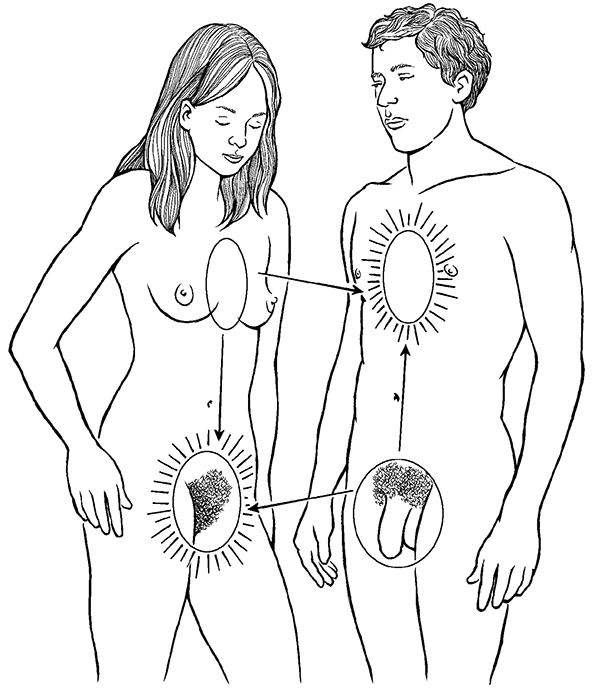
Figure 1.12
While he may be acting from a lower chakra physical/sexual level, bringing her attention to this area, she may in turn stimulate his heart chakra by emanating at this level.
|
Chakra |
One |
Two |
|
Sanskrit Name |
Muladhara |
Swadhisthana |
|
Meaning |
Root Support |
Sweetness |
|
Location |
Perineum |
Sacrum |
|
Element |
Earth |
Water |
|
Energy State |
Solid |
Liquid |
|
Psychological Function |
Survival |
Desire |
|
Resulting in: |
Grounding |
Sexuality |
|
Identity |
Physical identity |
Emotional identity |
|
Orientation to Self |
Self-preservation |
Self-gratification |
|
Demon |
Fear |
Guilt |
|
Developmental Stage |
Womb–12 mos. |
6–24 mos. |
|
Glands |
Adrenal |
Gonads |
|
Chakra |
One |
Two |
|
Other Body Parts |
Legs, feet, bones, |
Womb, genitals, kidney, |
|
Malfunction |
Obesity, anorexia, Sciatica, |
Sexual problems, |
|
Color |
Red |
Orange |
|
Seed Sound |
Lam |
Vam |
|
Vowel Sound |
Oh as in rope |
Oo as in pool |
|
Sephiroth |
Malkuth |
Yesod |
|
Planets |
Earth, Saturn |
Moon |
|
Metals |
Lead |
Tin |
|
Foods |
Protein |
Liquid |
|
Chakra |
One |
Two |
|
Gemstones |
Ruby, garnet, hematite |
Coral, carnelian, yellow zircon |
|
Incense |
Cedar |
Damiana |
|
Yoga Path |
Hatha |
Tantra |
|
Rights |
to have |
to feel |
|
Gunas |
Tamas |
Tamas |
|
Chakra |
Three |
Four |
Five |
|
Sanskrit Name |
Manipura |
Anahata |
Vissudha |
|
Meaning |
Lustrous gem |
Unstruck |
Purification |
|
Location |
Solar Plexus |
Heart |
Throat |
|
Element |
Fire |
Air |
Sound, ether |
|
Energy State |
Plasma |
Gas |
Vibration |
|
Psychological Function |
Will |
Love |
Communication |
|
Resulting in: |
Power |
Peace |
Creativity |
|
Identity |
Ego identity |
Social identity |
Creative identity |
|
Orientation to Self |
Self-definition |
Self-acceptance |
Self-expression |
|
Demon |
Shame |
Grief |
Lies |
|
Developmental Stage |
18–42 mos. |
3.5–7 years |
7–12 years |
|
Glands |
Pancreas, adrenals |
Thymus |
Thyroid, parathyroid |
|
Chakra |
Three |
Four |
Five |
|
Other Body Parts |
Digestive system, liver, gall bladder |
Lungs, heart, circulatory system, arms, hands |
Throat, ears, mouth shoulders, neck |
|
Malfunction |
Digestive troubles, chronic fatigue, hypertension |
Asthma, coronary disease, lung disease |
Sore throats, neck and shoulder pain, thyroid troubles |
|
Color |
Yellow |
Green |
Bright blue |
|
Seed Sound |
Ram |
Yam |
Ham |
|
Vowel Sound |
Ah as in father |
Ay as in play |
Ee as in sleep |
|
Sephiroth |
Hod, Netsach |
Tiphareth |
Geburah, Chesed |
|
Planets |
Mars (also Sun) |
Venus |
Mercury |
|
Metals |
Iron |
Copper |
Mercury |
|
Foods |
Starches |
Vegetables |
Fruits |
|
Chakra |
Three |
Four |
Five |
|
Gemstones |
Amber, topaz apetite |
Emerald, tourmaline, jade |
Turquoise |
|
Incense |
Ginger, woodruff |
Lavender |
Frankinscense, benzoin |
|
Yoga Path |
Karma |
Bhakti |
Mantra |
|
Rights |
to act |
to love |
to speak and be heard |
|
Gunas |
Rajas |
Rajas/Sattva |
Rajas/Sattva |
|
Chakra |
Six |
Seven |
|
Sanskrit Name |
Ajna |
Sahasrara |
|
Meaning |
Command center |
Thousand fold |
|
Location |
Brow |
Top of Head |
|
Element |
Light |
Thought |
|
Energy State |
Luminescence |
Consciousness |
|
Psychological Function |
Intuition |
Understanding |
|
Resulting in: |
Imagination |
Bliss |
|
Identity |
Archetypal identity |
Universal identity |
|
Orientation to Self |
Self-reflection |
Self-knowledge |
|
Demon |
Illusion |
Attachment |
|
Developmental Stage |
Puberty |
Throughout life |
|
Glands |
Pineal |
Pituitary |
|
Chakra |
Six |
Seven |
|
Other Body Parts |
Eyes, base of skull, brow |
CNS, cerebral cortex |
|
Malfunction |
Vision problems, headaches, nightmares |
Depression, alienation, confusion |
|
Color |
Indigo |
Violet, white |
|
Seed Sound |
Om |
None |
|
Vowel Sound |
Mmmm |
Ng as in sing |
|
Sephiroth |
Binah, Chokmah |
Kether |
|
Planets |
Jupiter, Neptune |
Uranus |
|
Metals |
Silver |
Gold |
|
Foods |
Entheogens |
Fasting |
|
Chakra |
Six |
Seven |
|
Gemstones |
Lapis, quartz |
Diamond, amethyst |
|
Incense |
Mugwort |
Myrrh, gotu kola |
|
Yoga Path |
Yantra |
Jnana |
|
Rights |
to see |
to know |
|
Gunas |
Sattva |
Sattva |
INTRODUCTORY CONCLUSIONS
It is at this point that some of the basic theories and biases of this book need to be presented. There is much that corresponds to standard systems (if one can find enough agreement to even say what those are), yet many things differ. The theories in the following pages are the result of making connections between the beliefs of the past, present, and projected future of researched information on the Chakra System, as well as numerous other relevant metaphysical and psychological systems.
This is meant to be presented as theory, not dogma; the presentation of an idea, not a religion. Hopefully, it is something valuable to the expansion of one’s consciousness regardless of religious or philosophic orientation. The theses are as follows:
• There are seven major and several minor chakras in the subtle body which act as gateways to dimensions spanning from matter to consciousness.
• In the human being, these seven planes correspond to archetypal levels of consciousness as well as various physical attributes.
• The chakras are created by the interpenetration of two major vertical currents.
• The lower chakras are of equal value and importance to the upper chakras for human beings at our present level of development.
• The Chakra System describes a pattern of evolution, and the human race is presently going from the third level to the fourth.
• The chakras also correspond to colors, sounds, deities, dimensions, and other subtle phenomenon.
• The System has immense value for personal growth and use in diagnosis and healing.
• These seven levels are proportional to the possible number of planes in a similar ratio to the seven colors of the rainbow and the spectrum of electromagnetic waves. The seven basic chakras are merely the vibrations that we can perceive with our present “equipment,” just as the colors of the rainbow are all that we can perceive with the naked eye.
• The chakras are in constant interplay and can only be separated intellectually.
• The chakras can be opened through various physical exercises, tasks, meditations, healing methods, life experiences, and general understanding, leading to more profound states of consciousness.
PRELIMINARY EXERCISES
Alignment
In order for the chakras to work smoothly, they need to be aligned with each other. The most direct alignment is with the spine relatively straight (a spine too straight is rigid and tense, blocking the opening of the chakras).
Standing with feet shoulder-width apart, stretch your hands up high over your head, reaching with your whole body, stretching out each of your chakras. Feel how this elongated position encourages the chakras to align.
When you return to a normal standing position, try to maintain that sense of height, aligning your body so that the central core of each major section (pelvis, solar plexus, chest, throat, head) feels in direct alignment with the central axis of your body. Allow your feet to connect solidly below you and feel the central core (sushumna) that connects all the chakras.
Practice the same alignment from a seated position, either in a chair or cross-legged on the floor. Try slouching and returning to an erect spine, feeling the difference in your body’s energy and your mind’s clarity.
Establishing the Currents
The Manifesting Current
Stand or sit comfortably, spine straight, feet planted firmly on the floor, shoes off. Tune into the vertical axis of your body. Allow yourself to find a comfortable position of balance where this vertical axis is calm, centered, and effortless to maintain. Breathe slowly and deeply.
Mentally reach out through the top of your head and allow yourself to experience the infinite vastness of the sky and space above you. Breathe into this vastness and imagine yourself drinking it in through the top of your head, pulling it down into your head, letting it cascade across your face, your ears, the back of your head, and down across your shoulders and arms.
Allow your head to fill again with this “cosmic” energy, this time letting it tumble into your neck, down into your chest, filling it as you breathe in . . . and out . . . in . . . and out. As the chest fills, let your belly release, allowing this energy to fill your solar plexus, your abdomen, your genitals and down into your buttocks, through your legs, into your feet and out. Let it go deep into the Earth.
Go back to the top of your head and repeat. As you begin the process again, you may choose to think of this energy in a more concrete form: as light, a particular color, a form of divinity, a column of bubbles or stream of wind, or just simply movement. Repeat the process until you feel that your image comes easily and flows smoothly from above your crown to the Earth below your feet.
The Liberating Current
When the above exercise is comfortable, you can begin working with the upward current in a similar manner.
Through your feet and legs, imagine energy from the Earth (red, brown, or green; solid, yet vibrant) coming up through your legs into your first chakra, filling up there and flowing on into your genitals, abdomen, and solar plexus. Filling again into your heart and chest, neck and shoulders, face and head, and out through the top of your head, releasing any tension it encounters outward and above. Work with this current until it, too, flows smoothly.
When these two currents are smooth, try running both of them at once. See them mixing and combining together at each of the chakra levels. (If you would like to work with colors, see the meditations at the end of Chapter 7, “Chakra Six.”)
As you go through your day, be aware of these two currents running through you. Make observations as to which one is stronger and at what times of the day or during what activities. Perhaps your body needs to develop one current more than the other in order to balance your energies. Notice where a current may get hung up on a particular block of tension. Play with the two currents and see which one is more effective in pushing through the block.
ENDNOTES
1. From a song by Rick Hamouris, recorded on Welcome to Annwfn, available from Nemeton, P.O. Box 8247, Toledo, Ohio.
2. Chakras and energy currents are mentioned in the Atharva Veda, (10.2.31), (15.15.2–9).
3. Georg Feurstein, in The Shambhala Encyclopedia of Yoga, refutes the Aryan invasion theory and pushes the date of the Vedas back into the third or fourth millennium bce. He counters that the lighter-skinned Aryans were native to India, due to similarities in the ancient Indus-Sarasvati civilization.
4. Troy Wilson Organ, Hinduism, 183.
5. The eightfold path consists of the yamas (restraints), niyamas (observ-ances), asana (postures), pranayama (breathing), pratyahara (withdrawal of senses), dharana (concentration), dhyana (absorption), and samadhi (enlightenment).
6. Arthur Avalon, The Serpent Power: The Secrets of Tantric and Shaktic Yoga.
7. The Serpent Power actually lists six centers, plus the Sahasrara (thousand-petaled lotus of the crown).
8. The five Koshas are: annamayakosha, or physical sheath, pranamayakosha, or energy sheath, manamayakosha, or mind sheath, vijnanamayakosha, or wisdom sheath, and anandamayakosha, or bliss body.
9. See Georg Feurstein, The Shambhala Encyclopedia of Yoga, 68–69. Nine chakras are described in Pandit Rajmani Tigunait, Ph.D. Sakti: The Power in Tantra, A Scholarly Approach (Honesdale, PA: Himalayan Institute, 1998), 111.
10. Chakras one and two are combined as one center, as are chakras six and seven, giving five in all.
11. Caroline Myss, Anatomy of the Spirit.
12. For more detail on comparing the chakra system and the ten sephiroth, see endnote 11.
13. Arthur Young, The Reflexive Universe.
14. See Rosalyn L. Bruyere, Wheels of Light: A Study of the Chakras.
15. For more active suggestions on ways to experience the chakras, including yoga postures, journal exercises, meditations, tasks, and rituals, see Judith and Vega, The Sevenfold Journey: Reclaiming Mind, Body, and Spirit through the Chakras.
16 . Classically, there are only five elements associated with the chakras—earth, water, fire, air, and ether, respectively from bottom to top. Chakra five is associated with sabda, or sound. It is my modernization that links the “elements” of light and thought to the upper two chakras.
17. For more explanation of excess and deficiency see my book Eastern Body, Western Mind.
18. For more details on chakras and childhood developmental stages, see my book Eastern Body, Western Mind.
19. Avalon, Serpent Power, 23.
20. The first chakra, however, contains the Shiva lingam, which is the form of Shiva invigorated by the presence of Kundalini-Shakti, who resides there in her sleeping form.
21. Sir Monier Monier-Williams, Sanskrit-English Dictionary, 811.
22. Lizelle Raymond, Shakti—A Spiritual Experience.
23. Swami Rama, “The Awakening of Kundalini,” Kundalini, Evolution, and Enlightenment, ed. John White (Anchor Books, 1979), 27.
24. Haridas Chaudhuri, “The Psychophysiology of Kundalini,” Ibid., 61.
25. Avalon, Serpent Power, 38.
26. Sri Aurobindo also describes ascending and descending currents in many of his writings.
27. Verses 10 and 11 of the Sat-Chakra-Nirupana, as translated by Arthur Avalon in Serpent Power.
28. Spiritual Emergence Network, run by California Institute of Integral Studies (415) 648-2610, or Kundalini Research Network, P.O. Box 45102, 2483 Younge St., Toronto, Ontario, Canada, M4P 3E3.
29. Philip Lansky, “Neurochemistry and the Awakening of Kundalini,” Kundalini, Evolution, and Enlightenment, ed. John White (Anchor Books, 1979), 296.
30. Lee Sannella, M.D. Kundalini: Psychosis or Transcendence? Also see Itzhak Bentov, Micromotion of the Body as a Factor in the Development of the Nervous System, 77 ff.
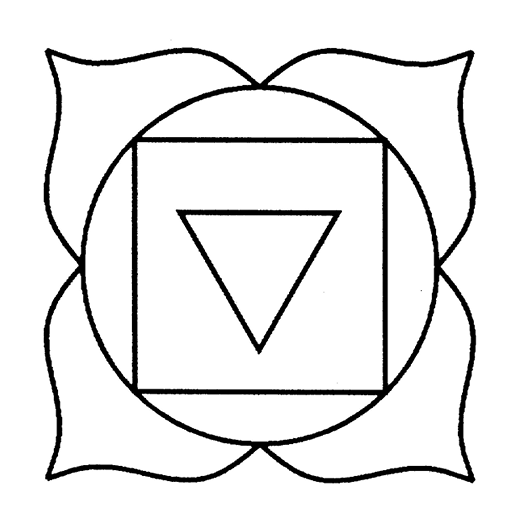
CHAKRA ONE
Earth
Roots
Grounding
Survival
Body
Food
Matter
Beginning